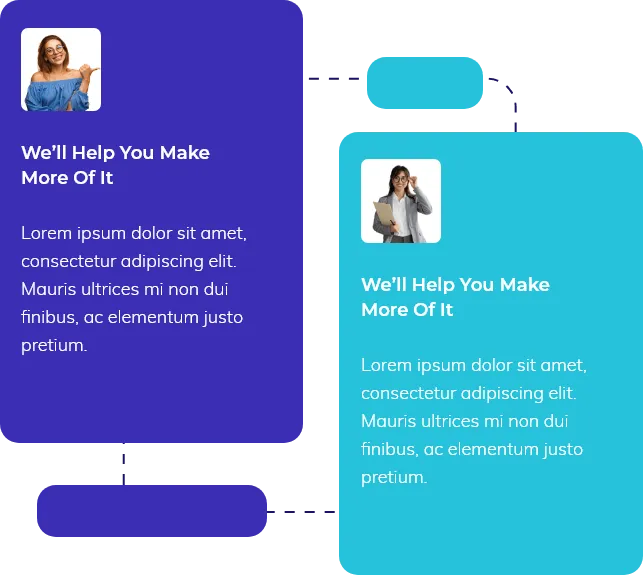


We’ll Help You Make More Of It
Committed To Helping Our Customers Succeed
Lorem ipsum dolor sit amet, consectetur adipiscing elit. Mauris ultrices mi non dui finibus, ac elementum justo pretium. Pellentesque porta elementum efficitur. Fusce nisl justo, eleifend sit amet dui in, porta ornare arcu.
Mauris ultrices mi non dui finibus, ac elementum justo pretium. Pellentesque porta elementum efficitur.
Fusce nisl justo, eleifend sit amet dui in, porta ornare arcu. Praesent eu tortor at
Trusted By Our Clients
★★★★★

Want a head start (or catch up)?
Feeling lost in the college application maze? Don't fret! Grab The College Timeline video and PDF to keep you on the path to success!
Check Out the Latest Advice

The Ultimate Guide to College Tours: What to Look For

Ready to master one of the most overlooked aspects of the college application process? College tours is a topic that (surprisingly) isn’t always on everyone’s radar, but should be! Get ready, because this guide is bursting with invaluable tips and insights you simply can't miss.
1. Programs Aren't Everything
Let’s be real, many parents and students are obsessed—yes, obsessed—with program rankings. Top engineering school? Woohoo! Ivy League badge? Bring it on! But hold on a sec. While it's cool to boast about your future alma mater's ranking, it’s not the end-all-be-all of your decision-making process. On the other hand, many people aren't sure where to begin with creating their college list, so they start by Googling ‘best _______ programs.’
Here's the kicker - how are these rankings even put together? Spoiler alert: they’re not as scientifically sound as you might think. You'll spend four years at this place, so the “vibe,” among many other things needs to be right. Your comfort, your happiness, affordability, your overall experience—that’s what really counts!
However, as far as tours are concerned, check out the programs. For instance, if you’re interested in majoring in business, take a tour of the business school. You’ll begin to learn how different colleges work within your specific major.
2. Consider Both Campus and Classroom Sizes
Small, medium, or large schools each offer a unique experience, and it’s essential to find your perfect match.
In general, sizes of colleges fall into the following categories:
Small: 10,000 students or less
Medium: 10,000-20,000 students
Large: 20,000+ students
Smaller schools offer a community feel and have a lot more opportunity for in-depth learning due to the ability to learn directly from your professors, but don't dismiss larger institutions either. They boast diverse opportunities, though their massive lecture halls could be overwhelming. If you’re visual like me, imagine your high school assembly split in half—that’s your class size at a large university. Can you thrive in a room with hundreds of students? Feel me?
So, if you find the idea of a packed classroom daunting, aim for smaller class environments. Always try to sit in on classes if possible. You want to get a feel for it and see if you can handle the energy (or lack thereof).
3. Location, Location, Location
Kind of like real estate, location is crucial when picking a college. Are you looking to stay close to home or ready to explore far-off states? My best advice on this is to pull up a map and start narrowing it down. Many students say they are “open” to different areas, when, in reality, it’s a handful of states.
Consider these aspects:
1. Proximity to Home: Do you want to come home on weekends? How many hours away by car or plane do you want to be?
2. City or Rural?: Do you need the hustle and bustle of city life, or are you happy with peace and quiet in a more remote campus? If you want to be “in the city,” does that mean literally in the city, or within an hour of a city?
3. Proximity to Activities: Love skiing or hiking? Make sure you're close to mountains or adventure spots. Do you want to be near a certain organization because you want to volunteer throughout the year? I once had a student that narrowed her list of schools based on their proximity to Irish dance studios. She was a competitive dancer, so it was important to her. Think about what’s important to you and take that into consideration when looking at colleges.
4. The Physical Campus—Oh, the Feels!
Close your eyes. Picture your dream college campus. Is it lush green lawns, water fountains, and Hogwarts-esque buildings? Or is it an urban setup with skyscrapers galore?
Your physical surroundings impact daily life. At a place like NYU, the “campus” spreads across city blocks. If crossing busy roads for classes doesn’t appeal to you, then a more encapsulated campus might be your thing. Prefer buildings closer together, or are you okay with a more sprawling setting?
Focus on what’s convenient for you. Taking a walk around and noting these details can help you narrow your college list when the time comes.
5. Campus Life – Find Your Tribe
Nothing beats the thrill of finding “your people.” Whether it’s clubs, sports, or just the daily campus vibe, finding your tribe is fundamental to enjoying college life fully.
When touring, watch students interact. How inclusive do they seem? Are people friendly? And remember, when possible, tour during the school year to feel the authentic day-to-day life. Noon on a random Tuesday in October offers much more insight than any summer tour ever could.
Be a people-watcher (without being creepy, of course). This will give you a better idea if this is the place you can call home for the next few years. For more ideas of what to look for and what to pay attention to, check out my video here on this topic where I give more detailed examples of what this looks like in practice.
6. Local Neighborhood – Beyond the Campus Bubble
So, you’ve fallen head over heels with the campus. But, what about the surrounding neighborhood? Step beyond the campus bubble. Walk a few blocks and soak up the local atmosphere. Do you feel safe? Excited? Comfortable?
Take UCLA, for example. The campus is downright gorgeous, but a couple of blocks off some find the area a tad sketchy. Many students don’t mind and feel perfectly safe, especially since you don’t leave campus much, while for others it’s a deal-breaker. It’s your call, but awareness is key.
Take the Official Tour – Ditch the Virtual!
Listen up, virtual tours are great for some preliminary research, but DO NOT count them as real tours. An on-campus official tour is unparalleled. You need to walk those grounds, see those buildings, and breathe that air.
If official tours are booked up, a self-guided tour is okay, but remember, it's not as immersive or informative. Always try to get on campus with an official guide during a regular school day to get the insider scoop. Obviously, sometimes this isn’t possible and you’ll need to do some tours in the summer, but try the best you can to do an official tour. You can sign up for tours on the college’s admissions office website.
Tip: Start college tours early!
When I say early, I mean 9th or 10th grade.
Though logical, many parents I work with say they want to wait until their child gets acceptances before they schedule tours, but this is a very bad idea. Most acceptances are in by March of senior year, that only gives you spring break to complete tours before National Decision Day on May 1st. Tours take time to schedule and plan, especially if you need to fly and need to budget for those expenses. Spreading them out will make the process much less stressful in the future.
It’s also very difficult, if not impossible, to narrow down a college list without tours. It’s like trying to find the perfect pair of jeans without trying them on. Tours give a student the experience and foundational knowledge to explore what they like or don’t like in a college campus.
One tip to make this easier is to check out colleges while you’re on vacation and make it a priority to check out some local schools when you can. If you’re already on vacation, why not stop by a college and take a tour? Even if the student doesn’t want to go to that college, check them out while you can. The information they’ll learn about themselves will be invaluable when the time comes to narrowing the schools they will apply to when the time comes.
Your college experience starts with the tour. Be intentional, be observant, and most importantly, be true to yourself. It's not just about program rankings or checking off boxes; it’s about envisioning your future and finding your place.
So, ready to conquer your college tours like the boss you are? Dive in, have fun, and may the odds be ever in your favor.
Want to make sure you don’t forget anything important on your tours? Grab my College Visit Checklist here. You got this!
For even more helpful information, be sure to check out the detailed video I’ve created! 🎥 It dives deeper into the topic and includes additional insights that may help you. Click here to Watch the video

As Featured In










Elisia's Top Picks

The Ultimate Guide to College Tours: What to Look For

Ready to master one of the most overlooked aspects of the college application process? College tours is a topic that (surprisingly) isn’t always on everyone’s radar, but should be! Get ready, because this guide is bursting with invaluable tips and insights you simply can't miss.
1. Programs Aren't Everything
Let’s be real, many parents and students are obsessed—yes, obsessed—with program rankings. Top engineering school? Woohoo! Ivy League badge? Bring it on! But hold on a sec. While it's cool to boast about your future alma mater's ranking, it’s not the end-all-be-all of your decision-making process. On the other hand, many people aren't sure where to begin with creating their college list, so they start by Googling ‘best _______ programs.’
Here's the kicker - how are these rankings even put together? Spoiler alert: they’re not as scientifically sound as you might think. You'll spend four years at this place, so the “vibe,” among many other things needs to be right. Your comfort, your happiness, affordability, your overall experience—that’s what really counts!
However, as far as tours are concerned, check out the programs. For instance, if you’re interested in majoring in business, take a tour of the business school. You’ll begin to learn how different colleges work within your specific major.
2. Consider Both Campus and Classroom Sizes
Small, medium, or large schools each offer a unique experience, and it’s essential to find your perfect match.
In general, sizes of colleges fall into the following categories:
Small: 10,000 students or less
Medium: 10,000-20,000 students
Large: 20,000+ students
Smaller schools offer a community feel and have a lot more opportunity for in-depth learning due to the ability to learn directly from your professors, but don't dismiss larger institutions either. They boast diverse opportunities, though their massive lecture halls could be overwhelming. If you’re visual like me, imagine your high school assembly split in half—that’s your class size at a large university. Can you thrive in a room with hundreds of students? Feel me?
So, if you find the idea of a packed classroom daunting, aim for smaller class environments. Always try to sit in on classes if possible. You want to get a feel for it and see if you can handle the energy (or lack thereof).
3. Location, Location, Location
Kind of like real estate, location is crucial when picking a college. Are you looking to stay close to home or ready to explore far-off states? My best advice on this is to pull up a map and start narrowing it down. Many students say they are “open” to different areas, when, in reality, it’s a handful of states.
Consider these aspects:
1. Proximity to Home: Do you want to come home on weekends? How many hours away by car or plane do you want to be?
2. City or Rural?: Do you need the hustle and bustle of city life, or are you happy with peace and quiet in a more remote campus? If you want to be “in the city,” does that mean literally in the city, or within an hour of a city?
3. Proximity to Activities: Love skiing or hiking? Make sure you're close to mountains or adventure spots. Do you want to be near a certain organization because you want to volunteer throughout the year? I once had a student that narrowed her list of schools based on their proximity to Irish dance studios. She was a competitive dancer, so it was important to her. Think about what’s important to you and take that into consideration when looking at colleges.
4. The Physical Campus—Oh, the Feels!
Close your eyes. Picture your dream college campus. Is it lush green lawns, water fountains, and Hogwarts-esque buildings? Or is it an urban setup with skyscrapers galore?
Your physical surroundings impact daily life. At a place like NYU, the “campus” spreads across city blocks. If crossing busy roads for classes doesn’t appeal to you, then a more encapsulated campus might be your thing. Prefer buildings closer together, or are you okay with a more sprawling setting?
Focus on what’s convenient for you. Taking a walk around and noting these details can help you narrow your college list when the time comes.
5. Campus Life – Find Your Tribe
Nothing beats the thrill of finding “your people.” Whether it’s clubs, sports, or just the daily campus vibe, finding your tribe is fundamental to enjoying college life fully.
When touring, watch students interact. How inclusive do they seem? Are people friendly? And remember, when possible, tour during the school year to feel the authentic day-to-day life. Noon on a random Tuesday in October offers much more insight than any summer tour ever could.
Be a people-watcher (without being creepy, of course). This will give you a better idea if this is the place you can call home for the next few years. For more ideas of what to look for and what to pay attention to, check out my video here on this topic where I give more detailed examples of what this looks like in practice.
6. Local Neighborhood – Beyond the Campus Bubble
So, you’ve fallen head over heels with the campus. But, what about the surrounding neighborhood? Step beyond the campus bubble. Walk a few blocks and soak up the local atmosphere. Do you feel safe? Excited? Comfortable?
Take UCLA, for example. The campus is downright gorgeous, but a couple of blocks off some find the area a tad sketchy. Many students don’t mind and feel perfectly safe, especially since you don’t leave campus much, while for others it’s a deal-breaker. It’s your call, but awareness is key.
Take the Official Tour – Ditch the Virtual!
Listen up, virtual tours are great for some preliminary research, but DO NOT count them as real tours. An on-campus official tour is unparalleled. You need to walk those grounds, see those buildings, and breathe that air.
If official tours are booked up, a self-guided tour is okay, but remember, it's not as immersive or informative. Always try to get on campus with an official guide during a regular school day to get the insider scoop. Obviously, sometimes this isn’t possible and you’ll need to do some tours in the summer, but try the best you can to do an official tour. You can sign up for tours on the college’s admissions office website.
Tip: Start college tours early!
When I say early, I mean 9th or 10th grade.
Though logical, many parents I work with say they want to wait until their child gets acceptances before they schedule tours, but this is a very bad idea. Most acceptances are in by March of senior year, that only gives you spring break to complete tours before National Decision Day on May 1st. Tours take time to schedule and plan, especially if you need to fly and need to budget for those expenses. Spreading them out will make the process much less stressful in the future.
It’s also very difficult, if not impossible, to narrow down a college list without tours. It’s like trying to find the perfect pair of jeans without trying them on. Tours give a student the experience and foundational knowledge to explore what they like or don’t like in a college campus.
One tip to make this easier is to check out colleges while you’re on vacation and make it a priority to check out some local schools when you can. If you’re already on vacation, why not stop by a college and take a tour? Even if the student doesn’t want to go to that college, check them out while you can. The information they’ll learn about themselves will be invaluable when the time comes to narrowing the schools they will apply to when the time comes.
Your college experience starts with the tour. Be intentional, be observant, and most importantly, be true to yourself. It's not just about program rankings or checking off boxes; it’s about envisioning your future and finding your place.
So, ready to conquer your college tours like the boss you are? Dive in, have fun, and may the odds be ever in your favor.
Want to make sure you don’t forget anything important on your tours? Grab my College Visit Checklist here. You got this!
For even more helpful information, be sure to check out the detailed video I’ve created! 🎥 It dives deeper into the topic and includes additional insights that may help you. Click here to Watch the video


I was very impressed with this course and list of scholarships it provides. The lists of scholarships are up to date, active and available. This not only saved me hours of my own time trying to look up scholarships I qualify for but, it also provided a list of scholarships I would have never found on my own. Major plus is Elisia provided a comprehensive list of scholarships for people of color. Thank you Elisia!
★★★★★
Carlo L

This resource is a boon for students searching for financial aid, as it categorizes scholarships by accessibility—focusing on those that are easy to apply for, do not require a GPA, or have no income requirements. What makes this resource stand out is the meticulous attention to detail. Elisia has evidently put a lot of effort into compiling a list that is not only extensive, but also easy to navigate, making the often daunting task of finding scholarships much more manageable.
★★★★★
Robert B
Have no idea what you’re doing?
Check out our courses to get step-by-step guidance on every aspect of the college admissions process.

Want one-on-one support?
Schedule a consultation.
© 2024 College Insights®. All Rights Reserved.
All written content on this site is for information purposes only. Opinions expressed herein are solely those of Elisia Howard, unless otherwise specifically cited. Material presented is believed to be from reliable sources and no representations are made by our firm as to another parties’ informational accuracy or completeness. All information or ideas provided should be discussed in detail with an advisor, accountant, or legal counsel prior to implementation.
All third-party trademarks, including logos and icons, referenced in this website, are the property of their respective owners. Unless otherwise indicated, the use of third-party trademarks herein does not imply or indicate any relationship, sponsorship, or endorsement between College Insights® and the owners of those trademarks. Any reference in this website to third-party trademarks is to identify the corresponding third-party goods and/or services.
